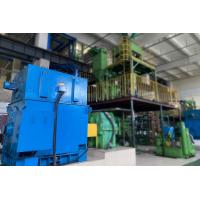What Is The Permanent Magnet Synchronous Motor?
The Permanent Magnet Synchronous Motor (PMSM) is a type of electric
motor that operates using permanent magnets embedded in its rotor.
It is also sometimes referred to as a brushless AC motor or a
synchronous permanent magnet motor.
In a PMSM, the stator (the stationary part of the motor) contains a
series of coils that are energized in a sequence to create a
rotating magnetic field. The rotor (the rotating part of the motor)
contains a series of permanent magnets that are arranged to produce
a magnetic field that interacts with the magnetic field produced by
the stator.
As the two magnetic fields interact, the rotor rotates, producing
mechanical energy that can be used to power machinery or other
devices. Because the permanent magnets in the rotor provide a
strong, constant magnetic field, PMSMs are highly efficient and
require less energy to operate than other types of electric motors.
PMSMs are used in a wide variety of applications, including
electric vehicles, industrial machinery, and household appliances.
They are known for their high efficiency, low maintenance
requirements, and precise control, which makes them a popular
choice for many different types of systems.
Working of Permanent Magnet Synchronous Motor
The working of the permanent magnet synchronous motor is very
simple, fast, and effective when compared to conventional motors.
The working of PMSM depends on the rotating magnetic field of the
stator and the constant magnetic field of the rotor. The permanent
magnets are used as the rotor to create constant magnetic flux and
operate and lock at synchronous speed. These types of motors are
similar to brushless DC motors.
The phasor groups are formed by joining the windings of the stator
with one another. These phasor groups are joined together to form
different connections like a star, Delta, and double and single
phases. To reduce harmonic voltages, the windings should be wound
shortly with each other.
When the 3-phase AC supply is given to the stator, it creates a
rotating magnetic field and the constant magnetic field is induced
due to the permanent magnet of the rotor. This rotor operates in
synchronism with the synchronous speed. The whole working of the
PMSM depends on the air gap between the stator and rotor with no
load.
If the air gap is large, then the windage losses of the motor will
be reduced. The field poles created by the permanent magnet are
salient. The permanent magnet synchronous motors are not
self-starting motors. So, it is necessary to control the variable
frequency of the stator electronically.
Analysis of the principle of the technical advantages of permanent
magnet motor
The principle of a permanent magnet synchronous motor is as
follows: In the motor's stator winding into the three-phase
current, after the pass-in current, it will form a rotating
magnetic field for the motor's stator winding. Because the rotor is
installed with the permanent magnet, the permanent magnet's
magnetic pole is fixed, according to the principle of magnetic
poles of the same phase attracting different repulsion, the
rotating magnetic field generated in the stator will drive the
rotor to rotate, The rotation speed of the rotor is equal to the
speed of the rotating pole produced in the stator.

Back-emf waveform:

Back emf is short for back electromotive force but is also known as
the counter-electromotive force. The back electromotive force is
the voltage that occurs in electric motors when there is a relative
motion between the stator windings and the rotor’s magnetic field.
The geometric properties of the rotor will determine the shape of
the back-emf waveform. These waveforms can be sinusoidal,
trapezoidal, triangular, or something in between.
Both induction and PM machines generate back-emf waveforms. In an
induction machine, the back-emf waveform will decay as the residual
rotor field slowly decays because of the lack of a stator field.
However, with a PM machine, the rotor generates its own magnetic
field. Therefore, a voltage can be induced in the stator windings
whenever the rotor is in motion. Back-emf voltage will rise
linearly with speed and is a crucial factor in determining maximum
operating speed.













